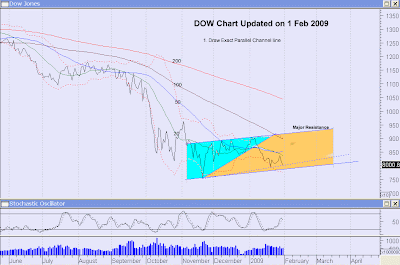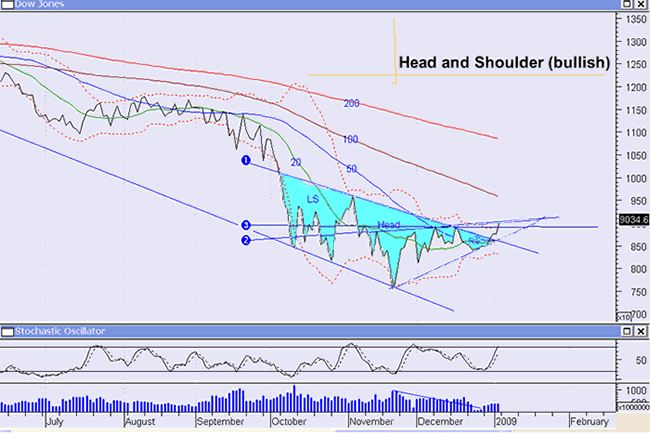IntroductionAfter having broken the support of the bearish rising wedge, DOW continued to edge lower, hugging against the lower Bollinger Band. It was in dangerous and critical condition when DOW's ADX rose above 20, where tradings would become more and more volatile. However, DOW was able to resist the selling pressures thus far and rebounced at the end of the last few trading sessions with relatively higher trading volume. It may be because DOW has found another support in an Ascending Channel.
What is an Ascending Channel?
An ascending channel is a set of upward sloping parallel lines that restrict the price/index movement as shown in the attached. Price/index may not always be within the parallel channel lines that show the support and resistance for price/index targets. A breakout above the upper channel line can signal continuation of an upward movement whereas a breakout below the lower channel line can signal a trend change.
Abnormal BehaviourUsually when a stock or index hugs and expands the lower bollinger band with ADX above 20, the tradings will not only be volatile but also brutal with daily falls expected to be more than 1%. However, DOW's behaviour in the last few sessions was quite abnormal. Instead of going down sharply as it should be, DOW was building up its resistances, showing bullish long tailed candlesticks with trading volumes above the norms. Such behaviour usually suggest that a support has been found and this could be the trendline shown blue in the attached.
How about STI and Hang Seng?The following charts suggest that STI and Hang Seng, which often track the movement of DOW, are showing similar resiliency and are trapped also in the ascending channel.

 Trading StrategyIf one has no vested interest in stock or equity or index market, it will be good to wait for the confirmation that DOW is:
Trading StrategyIf one has no vested interest in stock or equity or index market, it will be good to wait for the confirmation that DOW is:a) Not breaking the lower channel line;
b) rebouncing from this lower channel line with ADX changing its direction from going up to going down. For those who are vested and are preparing to ride through the "storm", it is good to watch that DOW will not break the final support @ 7,500 or to buy Put Warrants to hedge for the expected losses to be incurred.
1 Feb 2009 Update :
DOW rebounced but failed to break above the 20-day moving average. It is now sitting on a supporting trendline which was inadvertently shown as the lower channel line in the last posting. The updated chart will show that if this supporting trendline is broken, DOW may found support at the lower channel line. It will want to retest the low of 7,997 on 20 Nov 2008 when this lower channel line is broken.
It is quite likely that DOW would rebounce if the Obama's $825 bln stimulus package is passed by the Senate next week.
19 Feb 2009 Update:
The Obama stimulus package did not help to boost the market; instead, DOW broke away from the rising channel. It dipped 1.19% to a new low of 7,465 which is just below the November 2008's low of 7,552. It would appear that DOW had just formed another bearish flag, which would suggest 5,500 as the next target unless DOW could regain and reclaim its November 2008's low convincingly. DOW's present position is quite similar to the one in June 2008 as shown in the following graph.

click for enlarged view
18 April 2009DOW found itself trapped in another channel after Feb 2009 as shown in the attached weekly chart. This time a bullish declining channel.
 DOW appears to have a bullish look with the following observations:
DOW appears to have a bullish look with the following observations:a) It has just cleared the bullish declining channel;
b) It has recovered the last break of the "bear flag" line (as shown red in attached chart);
c) It has also cleared 20-week average and now is sitting above it;
DOW is believed to be heading for the resistance line, originated from Sept 2008; then, it will test the upper Bollinger line.
However, there are dangers signs around, signified by the falling 50 and 100 week averages. The 100-week average, which is about the cut under the 200-week average, appears to have a dangerous look.
The COPPOCK indicator suggested that the present market is still a trader's market and not a start of a bull market where long term investor can safely enter the market.
Disclaimer:
Information here is for sharing and learning. It is not intended to give any advice on any stock or movement or trend of any index. If a price or movement of a stock/index is given, it is only intended for illustration. The reader shall verify the information given here before using them.




















